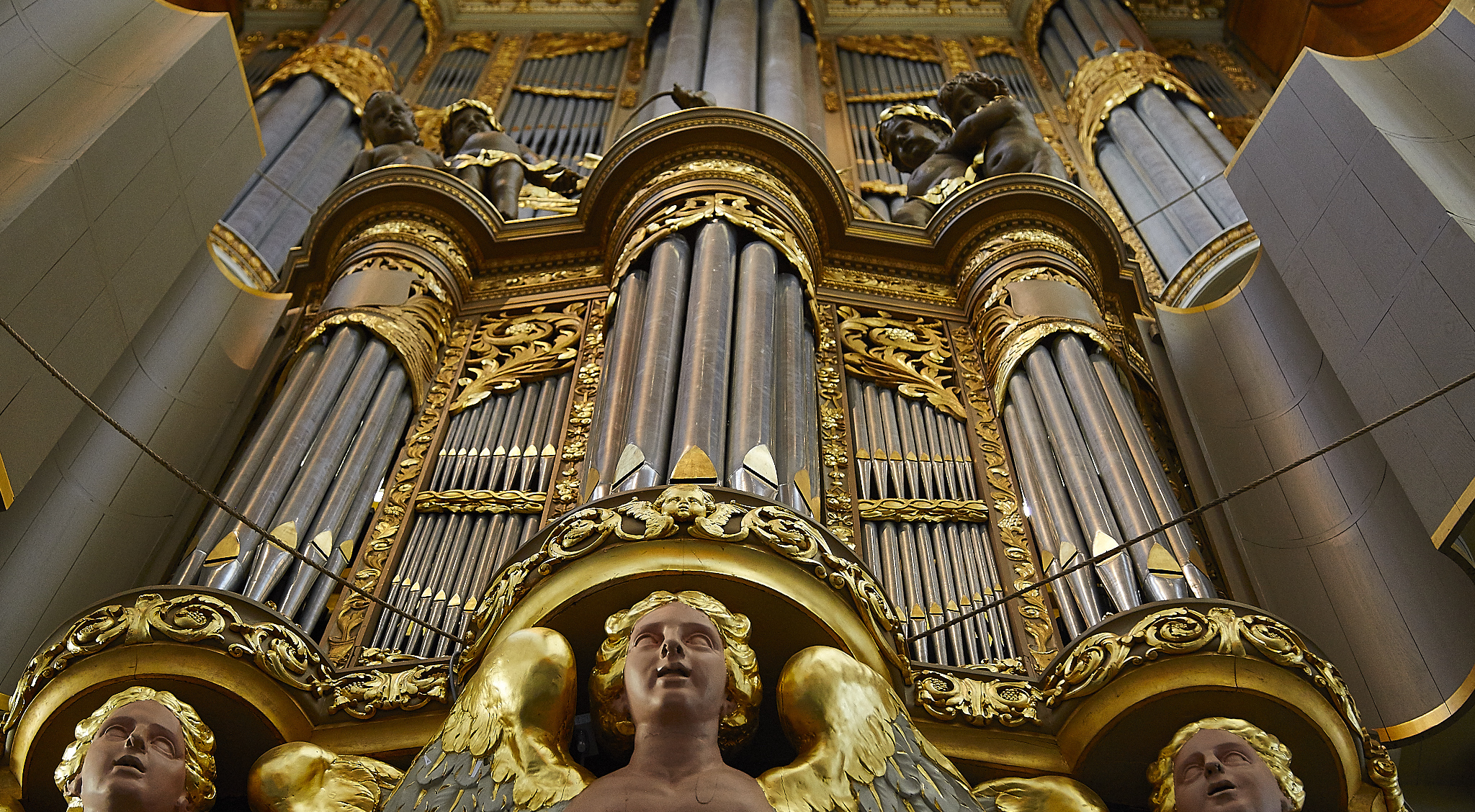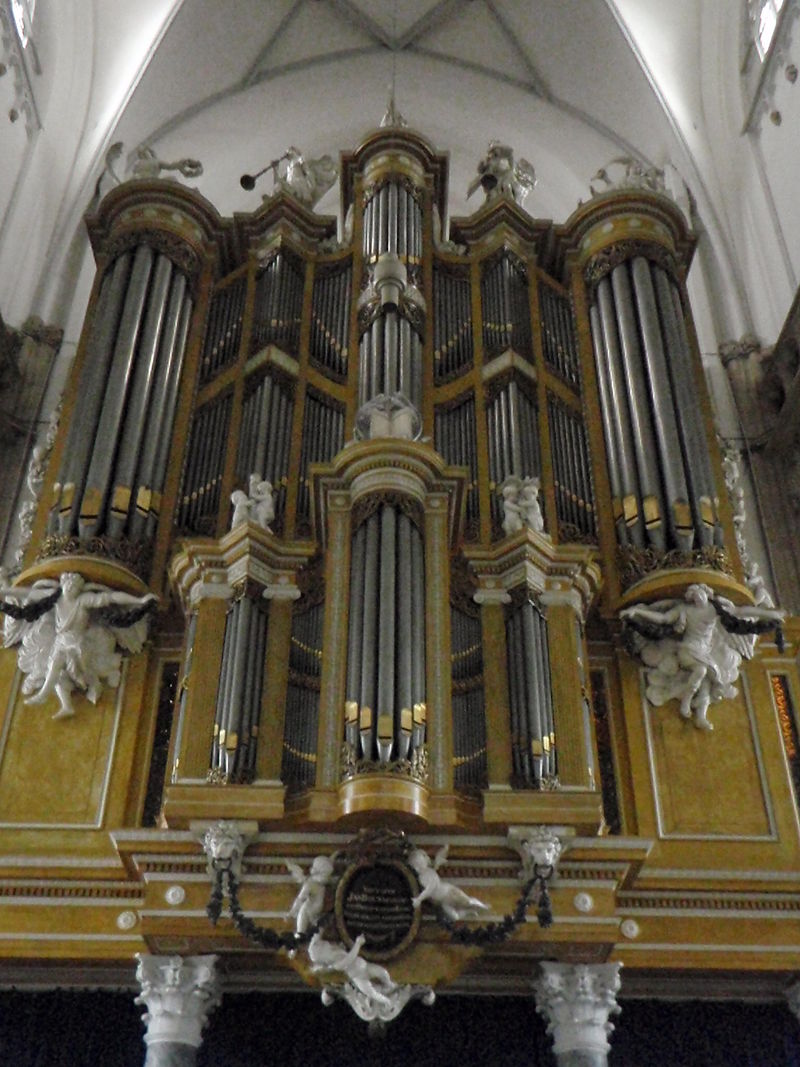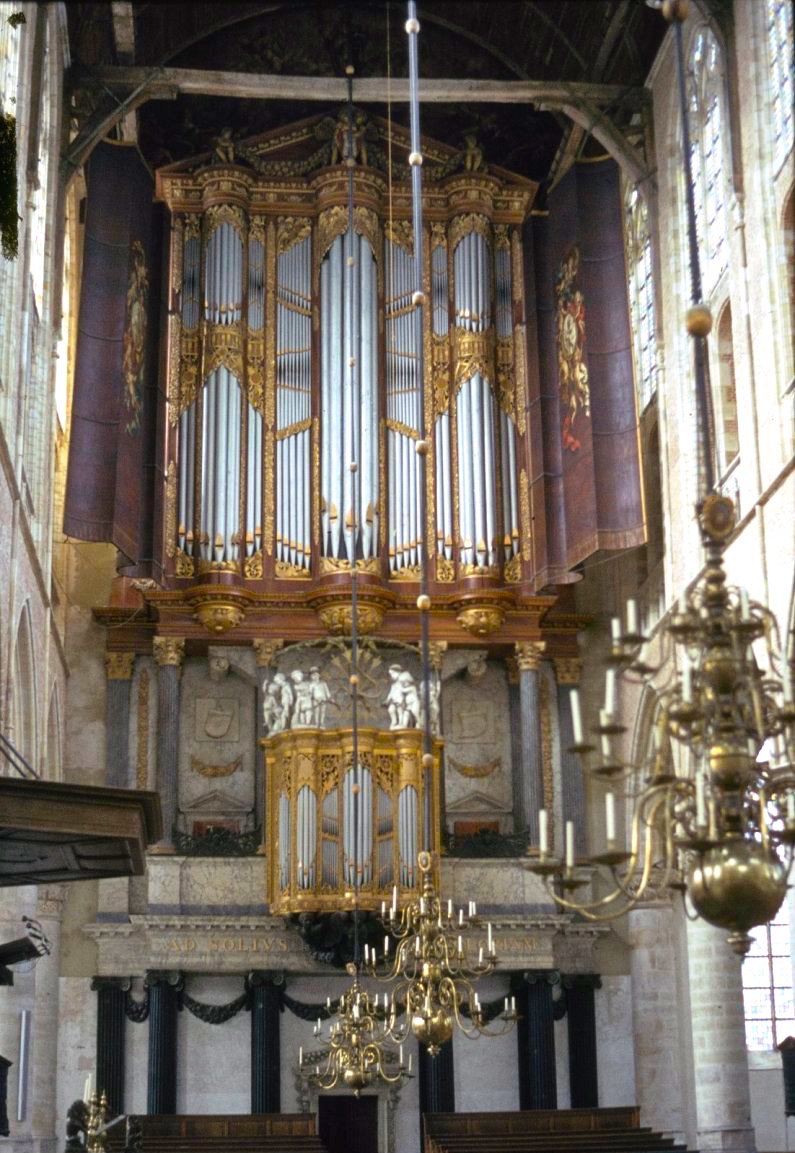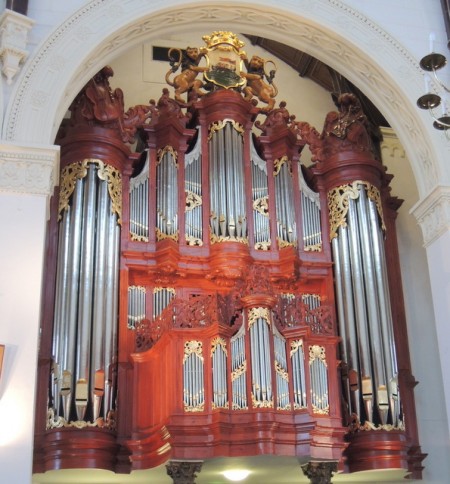


December 1, 2019
PIETER VAN DIJK
–––––––––––––––––––––––––––
A New Complete Bach Organ Works Recording

December 1, 2019
PIETER VAN DIJK
–––––––––––––––––––––––––––
A New Complete Bach Organ Works Recording

Detail of the 1639 Van Hagerbeer-Frans Caspar Schnitger organ at the Grote Kerk in Alkmaar, the Netherlands.
Detail of the 1639 Van Hagerbeer-Frans Caspar Schnitger organ at the Grote Kerk in Alkmaar, the Netherlands.
Introduction
In this interview, Pieter van Dijk, Professor of Organ at the Conservatorium van Amsterdam and the Hochschule für Musik und Theater Hamburg, and the City Organist of Alkmaar, discusses his new recording of the complete Bach organ works on historic instruments in the Netherlands, northern Germany, and Saxony with Vox Humana Editor Christopher Holman.
––––––––––––––––––––––––
Pieter, thank you very much for agreeing to this interview. To begin, could you talk about your musical training? Did you study piano from an early age? When did you take up the organ, and what attracted you to it?

I was born in Arnhem in the east of the Netherlands. My parents both played organ, piano, and sang, and as a young child I visited the Eusebiuskerk and went to organ concerts. The city was mostly destroyed during the Second World War, which included the Eusebiuskerk (this was especially a shame because it housed the only organ in the Netherlands made by the brothers Wagner and Schmiedefeld from Saxony). After the war, they rebuilt the church and in the 1960s bought the famous Strümpfler organ from the Lutheran Church in Amsterdam. The young organist in those days, Johan van Dommele, performed a wide repertory, and also organized a big series of concerts. I remember he played a whole concert of Reger one evening; another time he programmed modern pieces that nobody played, like the Heiller Tanz Toccata (which had just been composed a few years before). Starting in 1964, Johan van Dommele also organized an organ competition in Arnhem, and as a young boy I visited these competitions and heard young organists from all over the world play. I also heard Anton Heiller live several times, as he came regularly to give organ concerts.

My father was a doctor, but he also had a great love of instruments, and my parents both began taking private lessons with Johan van Dommele, who had a pipe organ in his home — an electric action unit organ — and my parents also decided to buy one. We lived in a late nineteenth century street in Arnhem with old houses and high roofs, and we had a big music room where such a thing made sense. Of course, as a child, I heard it all the time and thought, "I want to play that, too." At that time, my father was in contact with Bert Matter (the organ professor at the Conservatory in Arnhem) and asked him what to do with a boy of eight years who wanted to learn the organ. Bert Matter advised my father that I should start on the piano. The first six years I was educated at the music school in Arnhem on piano, but my interest in organ became stronger and stronger.
Bert Matter taught in the Eusebiuskerk and gave group lessons every week, which were in effect small concerts given by students. Because I was so interested, I asked if I could come. From the age of 14, I began to visit those group lessons and decided for sure that I wanted to study the organ. I was still in secondary school, but I took the entrance exams for the music school early. I studied for two years at the conservatory with Bert Matter before I started my formal university education.
Beyond your formal education, what has influenced your ideas of playing Bach?
I remember very strongly the impact of the recordings on me in my youth. A very important influence for me was Gustav Leonhardt, who recorded four discs on the organ at the Waalse kerk in Amsterdam (of pedal pieces that nobody ever heard him perform in concerts!). The way he played there was an enormous revelation. I listened to these discs hundreds of times, so I hope for some people that my recordings are an inspiration as well.
Working with students is, practically, helpful, because I get to hear the organs as the audience does. You quickly learn what works — or doesn't — if people play too fast on historic organs. In the organ loft you can think that the articulation is very clear, but downstairs, it's not enough. I'm also inspired by performances by baroque orchestras or solo period instruments like violins or traverse flutes. In Freiberg for example, I recorded the Vivaldi Grosse Mogul Concerto (arranged by Bach as BWV 594). Beforehand I listened to an old recording by Andrea Marcon with a very virtuosic violinist, and I tried to imitate the violin on the organ. I want to show that the organ is a dynamic instrument like all others, because I think many organ performances are not dynamic enough.
The other major influence is the manuscripts, which are now so easily available to us. As I said, I present other versions of pieces, and Bach Digital is so fantastic. I've really checked each note in the Neumeister Collection editions with the manuscripts, and sometimes there are mistakes. And then you have to ask if the solution in the edition is really the best. For my own development, I very much like to make these kinds of decisions, especially as there are very few autographs from Bach that we know for sure are "the best." It's very inspiring also to follow the new Breitkopf edition (which I also consult), but sometimes I find the solutions there not completely convincing, so I will try to find a better one. My work is to find a solution, and then listeners have to decide whether they agree. That's always open, and it's good that they have their own judgement and the freedom to use it.
You are presently making a recording of the complete Bach organ works under the DMP Records label. How did this project come to be, and what was your inspiration?

Seven or eight years ago, I met a director of a recording company from southern Germany who wanted to make a recording of me playing the Clavier-Übung III in Alkmaar. The organ there is a favorite for Bach because of Helmut Walcha's famous recording of The Art of Fugue. We recorded over five nights, but when he made the first edits, I was only happy with about 50%. So we had to do another round, and another, and eventually the CD never came out. I was frustrated, of course, because recording is a substantial investment, and I had really wanted to play these pieces on my own instrument.

There's a man on the Board of our Schnitger Organ Competition who was educated as a music engineer in The Hague and is the owner of the DMP Label. Some time later, I explained this situation and told him I wanted to make the same recording again. He was silent for a moment, and then he said he would do it, but on one condition: that we would record the entire Bach works together. And that was quite a surprise at first, but then I thought, "Why not? I love to play and practice Bach, and if I'm going to do it, I need to start before I get too old." We had several meetings to decide how we would plan it, and we decided to record half in Alkmaar because I know the instrument very well and am the City Organist there. Then we discussed which other instruments would contrast well.
At some level, the idea was to use instruments which are very good but not well-known internationally. I made the first part of this new recording in Alkmaar of the Clavier-Übung III, as I had originally planned (available here).
Johann Sebastian Bach: Prelude in E-flat Major, BWV 552, performed by Pieter van Dijk on the 1639 Van Hagerbeer-Frans Caspar Schnitger organ at the Grote Kerk in Alkmaar, the Netherlands.

For volume 2 (available here) we went to Purmerend, a small city north of Amsterdam. The instrument there was made by Rudolph Garrels, born in Norden, who worked with Arp Schnitger and later went to Holland. He tried to adapt to the Dutch tradition more so than Frans Caspar Schnitger, but even in the Netherlands, this organ was forgotten because the church was closed and made into a theater. The new owner did not want the organ, so it was dismantled and stored at Flentrop Orgelbouw for 25 years. Once the theater went out of business, the building became a church again, but Catholic, rather than Protestant as it had been. About 12 years ago the organ was restored by Flentrop. But because of all this, there was no organ tradition in Purmerend, and while now many organists in the Netherlands have heard of the organ, very few have heard it live. So I thought it was important to make such an important instrument better known. The strengths of the instrument are the smaller ensemble sounds, and the solo registrations there are also very nice:
Johann Sebastian Bach: Ich ruf zu dir, Herr Jesus Christ, BWV 639, performed by Pieter van Dijk on the 1742 Rudolph Garrels organ at the Nicolaaskerk in Pumerend, the Netherlands.

Volume 3 (available here) is the Leipzig Chorales, which I recorded in Alkmaar, as well as the eight Little Preludes and Fugues. We don't know if Bach himself wrote them (probably not), but they are probably known by everyone who starts playing the organ. I thought the combination of very well-known works, the Leipzig Chorales and the Little Preludes and Fugues gives a good variety to the program.
Johann Sebastian Bach: Allein Gott in der Höh sei Ehr, BWV 664, performed by Pieter van Dijk on the 1639 Van Hagerbeer-Frans Caspar Schnitger organ at the Grote Kerk in Alkmaar, the Netherlands.
Then the fourth double CD that was released recently (available here), is made on two Gottfried Silbermann organs: the famous one at the Cathedral in Freiberg, and an instrument in the village of Ponitz, which is quite similar to the lost organ at the Frauenkirche in Dresden (and the largest village organ Silbermann ever built). Both instruments are very well preserved. In Freiberg the program consists of Bach works that were influenced by French music — the Pièce d'Orgue, the Fantasy in C Minor, and other famous works, but from less well-known sources. I had recorded the Chorale Partita Sei gegrüßet, Jesu gültig twice before, so I chose to play the earliest manuscript of the piece, preserved in Carpentras, France (that version was given to Christoph Heinrich Rinck from Johann Christian Kittel, then it came to Carpentras). The order of the variations is different, and some have completely different notes. I think it's very refreshing to hear that there's not just one possibility, and in copies sometimes you find convincing alternate versions. I also think it's refreshing for people to have a recording available in another version.
As another example, the Canzona in D Minor on that recording is from a copy by Gottlieb Preller, whose source suggests it is a manualiter piece; Jean-Claude Zehnder thinks that the Preller copy is the closest to Bach's own version from the Möller manuscript. I decided to play the Preller's ornaments, which are quite different, and have not been recorded, to my knowledge. We don't know if Bach ever played it like that — but at least his Weimar circle around 1750 was using these French ornaments in a very intense way.
Then the fifth double CD (available here) is the Neumeister Collection combined with very well-known free pieces like the sixth Trio Sonata:
Johann Sebastian Bach: Sonata in G Major, BWV 530: I. Vivace, performed by Pieter van Dijk on the 1639 Van Hagerbeer-Frans Caspar Schnitger organ at the Grote Kerk in Alkmaar, the Netherlands.
This volume also includes the Toccata and Fugue in Dorian. I looked for some other versions of those pieces, and I am playing a copy by Johann Gottfried Walther, who includes many more ornaments in the fugue. Also, Johann Nikolaus Forkel gives a list of Bach's pieces with incipits of the themes, and it's interesting that his version has some ornaments which are not found in any printed manuscript, and of course nobody plays them. So in the exposition, I play the ornaments from Forkel, and later on I used the version from Walther. And there is the Prelude and Fugue in B Minor and Passacaglia and Fugue in C Minor; for the latter, I have decided to first record an earlier version from the Andreas Bach Book, and at the end I will play the version everyone knows on the pedal clavichord.
We are about halfway through the project now. For the next CD, I will play two organs by Antonius Hinsz, another pupil of Schnitger who made many instruments in Groningen and Friesland. The first is a two-manual organ in Harlingen, where Flentrop reconstructed the reed stops in a very beautiful manner. The other disc will be recorded in Bolsward, which was originally a two-manual instrument, but the organ builder Van Dam added a third manual in the nineteenth century. Then we have another disc in Alkmaar with the Schübler Chorales, then we move to northern Germany for the next set. One will be recorded at St. Katharinen in Hamburg on the reconstructed organ by Flentrop. This disc will have works influenced very strongly by the North German style, and the Chorale Fantasias; the other disc will be made in Lübeck on the Stellwagen organ in the Jakobikirche. There I will play very early Bach works and pieces that fit on short octave. The Art of Fugue in Alkmaar will be volume nine, as a nod to Mr. Walcha. The last volume will have three discs — the first will be made in Trondheim (I'll be making that at the end of this year, but we won't publish it until the end of the series), and I will focus on the early versions of the Leipzig Chorales. The second disc will be recorded in Alkmaar with all the remaining pieces and alternate versions (when it's useful to have them). The project should be finished in 2023.
Now that you're in the midst of this massive project, have you found that you've discovered anything about Bach or organs in general?
When recording the third CD of French-inspired music in Freiberg, there was a rather interesting story about the Gravement section of the Pièce d'Orgue. I had decided to play that part of the piece with many ornaments based on three sources with very dense ornamentation. I played a concert before the recording, and a friend and colleague was there; afterward I asked him, "Did you like my version?" His reaction was curious — he said, "Pieter, did you play it with ornaments?" I was shocked, and I was concerned, so I made the recording with all the ornaments, and then I went down to listen, and I understood what he meant, because the ornaments were completely unclear. I thought about it and realized that in an inégal Grand Plein jeu piece in French Classical music, most composers don't write many ornaments. Of course, there are exceptions (like Nicolas de Grigny, though he was not an organist in Paris), but the way the mixtures are composed in France is such that ornaments are very unclear. So I decided immediately during that session to make that recording without ornaments in the middle movements. That was, of course, a problem in a very French-influenced program, and it was after preparing it very carefully with all the ornaments (which is hard work!), but sometimes you have to change your plan because the instrument is telling you "I don't like this!" On the Alkmaar organ, though, the ornaments work very well on the same registration, so perhaps I will record my ornamented version at the end of the project in Alkmaar to give another idea of the piece.
How do you approach the registrations in such a huge project?
Many organs in Holland are predisposed to a certain design, and because of my experience on the Alkmaar organ, I know what basic registrations will sound good most of the time. My aim is to make the instruments sound as good as possible, to get the best sound of each. I also want to get as much as variety as possible, but without using registrations that Bach probably never knew. In the Passacaglia, for instance, I don't change registrations. But in the partitas, I try for as much variety possible between variations; I try not to repeat myself too much. That can be difficult, because on certain instruments some registrations are so beautiful that you always want to come back to them. When we were recording the Neumeister Collection, for example, my Alkmaar colleague Frank van Wijk said, "Pieter, we've worked together for 20 years, but I've never heard this registration in Alkmaar." That's exactly what I want! With instruments with which you aren't so well-acquainted, it becomes stressful if you have very little time to make recordings, and you have to work very quickly.
How do you think recordings have changed how we experience music today?
One of the very strange things we have nowadays compared to the past is that, in Bach's time, I suspect he always improvised a piece one time, and it was always fresh to the listeners. Nowadays, audiences react quite differently if you play an alternate version of a Bach work ("you made a lot of mistakes!") because they want to hear what they have always listened to. They want a repeat of what they have in their head. I think that is not a very good way to approach this fantastic music.
Very often, I remind my students that in the nineteenth and early twentieth centuries, if people wanted to learn symphonies by Brahms, Beethoven, etc., they had no recordings, and that listening to these today is effectively a lazy way of getting acquainted with a great repertory. When I was a student I had a friend who was very interested in playing four-hand piano works, so we went to our library in Arnhem and took out a reduction of the Symphony of César Franck and tried to play it together on the piano. In the score, phrases are marked for "oboes" or "horns", and you have to have a very strong imagination of instruments. You also have to make a reduction because it's often impossible to play all the notes, which is a very different process than sitting and listening to a fantastic performance by the Royal Concertgebouw Orchestra. Learning at the keyboard is a more active way of getting into the music. And that's the reason that people like Brahms published four hand versions of their symphonies.
What do you hope people will get from your recording? Is it a historical record of what you did at this moment, is it purely for enjoyment, or something else?
I'm realistic enough to know that it's just me at a certain moment, and I don't believe it's for eternity. But I hope that it works as a portrait of the instruments I've chosen. I want people to hear the different colors of the instruments and the balance, and because we always want to produce the best sound on a CD, we work a lot on the best position of the microphones. I also hope that people hear that my interpretations are in good harmony with the choice of instruments, and I hope also the recordings will inspire other ways of performing well-known pieces. And of course, this should always be with the freedom and space for people to say that "this is not my Bach" if they want.
But I am encouraged that many colleagues have subscribed to the whole series, and I like to hear their reactions. It's inspiring for me to continue this. I realize that you can never speak a "universal truth" in a CD. Recording is always personal, and it happens at one moment. By the end of this project, I hope I will still be happy with the first recordings, but you never know! But it's a fantastic and inspiring opportunity and challenge to be able to use these great instruments.
To close, here is the promotional video (Dutch with English subtitles) about the series with Pieter van Dijk:
––––––––––––––––––––––––
Editor's Note
The Vox Humana Editorial Board offers our sincerest thanks to DMP Records for their use of the audio examples throughout this interview. The entire recordings that have been released as of December 1, 2019 can be ordered here:
Volume 1
Volume 2
Volume 3
Volume 4
Volume 5
Subscriptions to the entire series are available here.
––––––––––––––––––––––––
Pieter van Dijk studied with Bert Matter at the Arnhem Conservatory, and continued his studies with Gustav Leonhardt, Marie-Claire Alain and Jan Raas. As a performer he was awarded prizes at international competitions in Deventer (1979) and Innsbruck (1986). His many recordings on historic organs throughout the Netherlands and beyond have included the Fugue State Films DVD The Organs of the Laurenskerk, which in 2013 was awarded the Preis der Deutsche Schallplattenkritik. In 2017 he commenced the recording of a complete Bach-cycle for DMP Records.
Pieter van Dijk’s research interests have led to the publication of articles about Weckmann, Sweelinck, Bach and the playing style of the great early 20th century German organist Karl Straube. He was one of the advisors behind the much-lauded reconstruction of the organ at the St Katharinenkirche in Hamburg, on which Bach famously performed in 1720.
As a performer and jury member at international competitions, Pieter van Dijk has appeared throughout Europe as well as in the USA and Japan.
The views and opinions expressed in this article are those of the author, and do not necessarily reflect the position of Vox Humana.